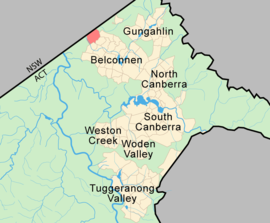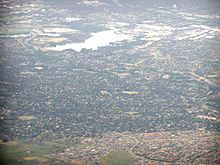- Dunlop, Australian Capital Territory
-
Dunlop
Canberra, Australian Capital Territory
Population: 5,851 (2006 census)[1] Established: Gazettal Date - 22 September 1993 [2] Postcode: 2615 District: Belconnen Assembly Electorate: Ginninderra Federal Division: Fraser Suburbs around Dunlop: New South Wales New South Wales Fraser New South Wales Dunlop Charnwood New South Wales Macgregor Charnwood Dunlop (postcode: 2615) is a suburb of Belconnen, Australian Capital Territory, Australia. Dunlop is located at the far north-west edge of Canberra, nearby the border with the state of New South Wales. Located approximately 11.6 kilometers north-west of the city, Dunlop is situated next to the suburbs of Fraser, Charnwood and Macgregor. At the edge and within Dunlop lies the Canberra Nature Park called Dunlop Grasslands Nature Reserve, West Belconnen Ponds, Jarramlee Pond and Fassifern Pond which are part of the Ginninderra Catchment.[3]
Dunlop is named after Lieutenant Colonel Sir Ernest Edward 'Weary' Dunlop , AC, CMG, OBE (Edward Dunlop) who was an Australian surgeon and was renowned for his leadership whilst being held prisoner of war by the Japanese during World War II. He was born in Wangaratta, Victoria, Australia. Streets in Dunlop are named after inventors, inventions and artists.[2]
Contents
Demographics
In the 2006 Australian Census (held on 8 August 2006), there were 5,851 persons usually resident in Dunlop (Suburb): 49.9% were males and 50.1% were females. Of the total population in Dunlop (Suburb) 1.6% were Indigenous persons, compared with 2.3% Indigenous persons in Australia.[1]
The Census showed 26.9% of the population usually resident in Dunlop (Suburb) were children aged between 0–14 years, and 10.2% were persons aged 55 years and over. The median age of persons in Dunlop (Suburb) was 29 years, compared with 37 years for persons in Australia.[1]
The 2006 Census depicted 91.5% of persons usually resident in Dunlop (Suburb) were Australian citizens, 17.9% were born overseas and 0.4% were overseas visitors. The 2006 showed that 78.4% of persons usually resident in Dunlop (Suburb) stated they were born in Australia. Other common responses within Dunlop (Suburb) were: England 3.3%, New Zealand 1.2%, Viet Nam 1.2%, Philippines 0.8% and Scotland 0.7%.[1]
In the 2006 Census, the most common responses for religious affiliation for persons usually resident in Dunlop (Suburb) were Catholic 29.3%, No Religion 22.2%, Anglican 17.7%, Uniting Church 4.4% and Buddhism 2.9%. The 2006 Census also revealed that In the 2006 Census, 55.8% of persons aged 15 years and over usually resident in Dunlop (Suburb) were married, 31.3% never married, 10.8% separated or divorced and 2.1% widowed.[1]
In Dunlop (Suburb), the median weekly individual income for persons aged 15 years and over who were usual residents was $795, compared with $466 in Australia. The median weekly household income was $1,612, compared with $1,027 in Australia. The median weekly family income was $1,700, compared with $1,171 in Australia. In the 2006 Census, there were 1,655 families in Dunlop (Suburb): 52.7% were couple families with children, 33.0% were couple families without children, 13.1% were one parent families and 1.3% were other families.[1]
In the Census there were 2,008 occupied private dwellings counted in Dunlop (Suburb): 96.7% were separate houses, 3.3% were semi-detached, row or terrace houses, townhouses etc., 0.0% were flats, units or apartments and 0.0% were other dwellings.[1]
 A bronze statue of Edward Dunlop at the Australian War Memorial, Canberra, Australian Capital Territory, 2nd of an edition of two by sculptor Peter Corlett, the other in the Royal Botanic Gardens, Melbourne
A bronze statue of Edward Dunlop at the Australian War Memorial, Canberra, Australian Capital Territory, 2nd of an edition of two by sculptor Peter Corlett, the other in the Royal Botanic Gardens, Melbourne
.
Schools and Churches
There are no schools within the Dunlop suburb. In the nearby suburbs of Charnwood, Fraser and Macgregor there are several public schools and independent schools; Charnwood-Dunlop Primary School, Fraser Primary School, Macgregor Primary School and St.Thomas Aquinas Catholic Primary School. The nearby High Schools and Colleges are the, 'super' school, Ginninderra District School, Melba-Copland School and St Francis Xavier College.
In the suburb of Charnwood there are two churches. In the now closed Charnwood High School is the Canberra Christian Life Centre and just down the road is Saint Thomas Aquinas Catholic Church.
Playgrounds and Parks
In the Dunlop suburb there are around 8 children's playgrounds for all ages with an array of play equipment. There are also a number of parks that are grassed and covered with different varieties of trees, large rocks to play on and walking and cycle paths.
Estates
The suburb of Dunlop has been designed to have a number of 'estates' which are small areas within the suburb. Some estates range from the beginning of the development of Dunlop and number around 50 houses to the recent development of Ginninderra Ponds with house numbering around in the 100's. All the estates entrances have unique signs and features.
The estates are:
- The Meadows
- Ginninderra Ridge
- Ginninderra Ponds
- Dunlop Hills
- Jarramlee Park
Some street names in the suburb of Dunlop are:
- Akubra Place - Akubra is an Australian brand of hat, whose wide-brimmed styles are a distinctive part of Australian culture, especially in rural areas. The name is believed to be derived from an Aboriginal word for head covering.
- Buckmaster Crescent - Ernest William Buckmaster (1897–1968) Australian artist born in Victoria who won the Archibald Prize in 1932 with a portrait of Sir William Irvine.
- Evelyn Owen Crescent - Evelyn Ernest Owen (15 May 1915–1 April 1949) was an Australian who developed the Owen Submachine Gun which was used in World War II, Korean War and the Vietnam War.
- Lance Hill Avenue - he manufactured the Hills hoist, in 1945 in Adelaide. A Hills hoist is a height-adjustable rotary clothes line.
- Polilight Street - The Polilight is a portable, high-intensity, filtered light source used by forensic scientists and others to detect fingerprints, bodily fluids and other evidence from crime scenes and other places.
- Stump Jump Crescent - The stump-jump plough is a kind of plough invented in South Australia in the late nineteenth century by Richard Bowyer Smith to solve the particular problem of preparing mallee lands for cultivation.
- Victa Place - The Victa lawn mower was invented in 1952, in Concord a suburb of Sydney, Australia, by Mervyn Victor Richardson.
The median house price for the Dunlop suburb (2011) is $486,750.[4]
Fassifern Homestead/ Equestrian Park
Fassifern Homestead was originally a working homestead but by the 1920s it was an active equestrian park.[5] Fassifern Homestead is currently unused and it is owned by Territory and Municipal Services (TAMS).[6][7]
Geology
Rocks in Dunlop are from the Silurian age. Deakin Volcanics purple rhyodacite is found in most of Dunlop. Grey tuff from the Laidlaw Volcanics was erupted on top in the south west. The Deakin Fault passes along the north east edge of Dunlop. On the north east of the fault the green-grey dacite and quartz andesite of the Hawkins Volcanics were uplifted.
References
- ^ a b c d e f g Australian Bureau of Statistics (25 October 2007). "Dunlop (State Suburb)". 2006 Census QuickStats. http://www.censusdata.abs.gov.au/ABSNavigation/prenav/LocationSearch?collection=Census&period=2006&areacode=SSC81131&producttype=QuickStats&breadcrumb=PL&action=401. Retrieved 13 July 2009.
- ^ a b "Suburb Name search results". ACT Planning & Land Authority. http://apps.actpla.act.gov.au/actlic/places/search/suburbResults_new3.asp?suburbName=DEAKIN&Submit=Continue. Retrieved 13 July 2009.
- ^ http://www.ginninderralandcare.org.au/content.php?id=40
- ^ http://www.allhomes.com.au/ah/act/property-research/dunlop/121486610
- ^ http://www.belconnen.org.au/belhist.htm
- ^ http://www.tams.act.gov.au/__data/assets/pdf_file/0004/131719/C.12_Strategic_Asset_Management.pdf
- ^ https://secure.ausport.gov.au/__data/assets/pdf_file/0020/382151/ACT_TAMS_AR_2008-2009.pdf
External links
- http://www.actpla.act.gov.au/tools_resources/maps_land_survey/place_names/place_search
- http://www.lda.act.gov.au/?/ginniponds/image_gallery
- http://www.police.act.gov.au/community-safety/crime-statistics/belconnen-patrol-zone/patrol-sector1.aspx
- http://www.ginninderralandcare.org.au/content.php?id=40
Categories:
Wikimedia Foundation. 2010.


